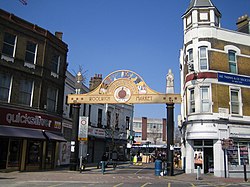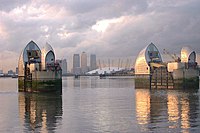Woolwich
| Woolwich | |
| Kent | |
|---|---|
 Woolwich Market | |
| Location | |
| Grid reference: | TQ435795 |
| Location: | 51°29’46"N, 0°4’5"E |
| Data | |
| Post town: | London |
| Postcode: | SE18 |
| Dialling code: | 020 |
| Local Government | |
| Council: | Greenwich |
| Parliamentary constituency: |
Greenwich and Woolwich |
Woolwich is a town in north-western Kent within the metropolitan conurbation standing on the south bank of the River Thames. The town is identified in the London Plan as one of 35 major centres in "Greater London".[1]
Woolwich has long been a notable river crossing point, for though there is no bridge over the broad waters of the Thames here, it is served by the Woolwich Ferry, a free vehicle ferry which sails between Woolwich and North Woolwich on the opposite bank. Standing within the ferry terminal is the entrance to the Woolwich foot tunnel which runs beneath the beneath the Thames on the same route.
Contents
Name of the town
In 1796 Daniel Lysons wrote, "this place in old charters is called Hulviz, Wolwiche, Wollewic, &c. I can find nothing satisfactory relating to its etymology."[2] It is now generally believed that the name Woolwich derives from the Old English name for "wool village" as a trading place for wool.
History
Woolwich has been inhabited since at least the Iron Age, and a Roman fort was found in the current Riverside park.[3]
Woolwich remained a small Kentish village until it started to become a leading military and industrial town. It was home to the Woolwich Dockyard (founded in 1512), the Royal Arsenal (dating back to 1471), the Royal Military Academy (1741) and the Royal Horse Artillery (1793). The town still retains and active army barracks; the Royal Artillery Barracks (and although 16RA Royal Artillery left in 2007, Woolwich Barracks still house the Royal Artillery Band and more recently Second Battalion Princess of Wales Royal Regiment and Kings Troop Royal Horse Artillery). The Royal Artillery Museum, Firepower, is found here too. The nearby Greenwich Heritage Centre also houses exhibits relating to the Royal Arsenal.
Arsenal Football Club was founded in Woolwich in 1886 by workers at the Royal Arsenal – the club were initially known as Dial Square, then Royal Arsenal and then became Woolwich Arsenal in 1891. The club moved to Arsenal Stadium, Highbury in Middlesex in 1913, and dropped the Woolwich prefix the following year. Royal Ordnance Factories FC was founded in response to Woolwich Arsenal joining the League but only lasted several years.
An early experiment in education was the Woolwich Polytechnic, founded in 1892, which lasted until it merged with other local colleges and became the blandly named Thames Polytechnic in 1970. In 1992 it was granted university status as the University of Greenwich and in 2000, the University moved out of Woolwich to its up-market neighbour and took lodgings in the grand buildings of the Royal Naval College in Greenwich.
The Woolwich Building Society was founded here. In latter years it demutualised, moved to Bexleyheath and became part of the Barclays group, but it retains the name of Woolwich.
Woolwich was the start of the route of the last London tram, on 5 July 1952.[4] A special tram was driven through enormous crowds to New Cross, finally arriving at New Cross depot around 1am on the 6 July.[5]
Woolwich was home to the experimental Auto Stacker car park. Built on the site of the Empire Theatre, it was officially opened in May 1961 by Princess Margaret. It was never actually used by the public and was demolished in 1962, after the council could not get it to work.
Woolwich is the location of the United Kingdom's first branch of McDonald's (the 3,000th in the world), which opened in 1974. Woolwich was chosen because it was considered to be a representative English town at the time.[6]
Woolwich once had four cinemas. Today, one, the former Granada cinema, is a bingo hall, another, the former ABC (previously Regal) is a nightclub, while the former Odeon, later Coronet (which once hosted Buddy Holly) is now a Pentecostal church. The Century cinema, which faced Beresford Square, was demolished for redevelopment in the late 1960s.
Recent development
Woolwich declined as a town in the late 20th century, starting with the closure of the Siemens factory in 1968 and continuing as the Royal Arsenal scaled back operations and finally closed in 1994. Without major local employers, the local economy was affected and the demographics of Woolwich changed. In the town centre, department and chain stores closed and the sprawl of the town centre shrank. The focus of shopping activity was limited mostly to Powis Street and the area around the market. By the early 1990s, the town centre had the typical appearance of a town in decline—discount retailers and charity shops using the empty stores. The local Council used several properties as offices. The last cinema, the Coronet, closed and in general Woolwich seemed to have lost its previous vigour.
However, once redevelopment of the former Royal Arsenal site began, Woolwich started to enjoy a small renaissance. Several High Street chains previously absent from Woolwich have opened branches, and longer-established shops have been refurbished. The new terminus of the Docklands Light Railway's London City Airport branch, Woolwich Arsenal station, opened on 10 January 2009.[7]
From 2007, large-scale development was planned to clear what has become a rather shabby town centre. Some local residents have been concerned about the design of the development, but demolition began, and the shape of the town is changing, with the intention of regeneration.
River transport
The free Woolwich Ferry service operates across the River Thames to North Woolwich carrying trucks, cars, cyclists and pedestrians during the day until 8pm on Weekdays. A two boat service runs on Mondays to Saturdays and Sundays only has a one boat service. Woolwich foot tunnel is also available for use by pedestrians (and cyclists pushing their cycles) at any time. It is served by lifts during traditional shopping hours.
London River Services, operated by Thames Clipper, provide a peak hour, seven days a week service to central London (Savoy Pier) from Woolwich Arsenal Pier (adjacent to the Royal Arsenal residential development).
The Thames flood barrier is located a mile upstream from the tunnel and ferry.
References
- ↑ Mayor of London (February 2008). "London Plan (Consolidated with Alterations since 2004)". Greater London Authority. http://www.london.gov.uk/thelondonplan/docs/londonplan08.pdf.
- ↑ [1]
- ↑ [2]
- ↑ BBC on this day: 6 July accessed 23 April 2007
- ↑ Greenwich Guide, day by day
- ↑ Interview with McDonalds UK CEO Evening Standard 16th December 1991 accessed 23 April 2007
- ↑ DLR service change from 10 January 2009, accessed 13 January 2009




